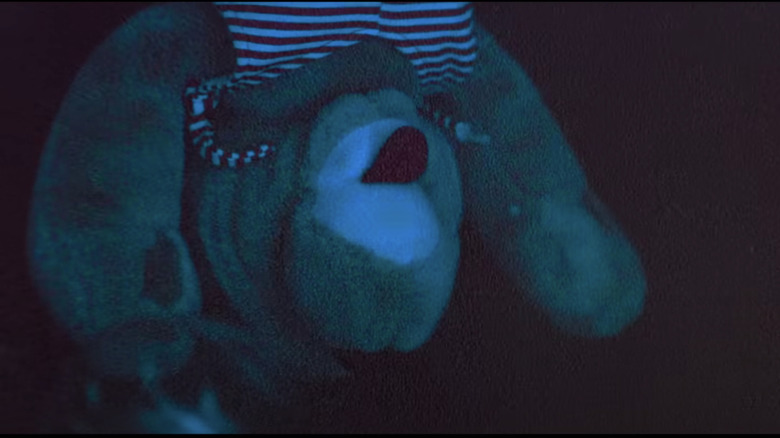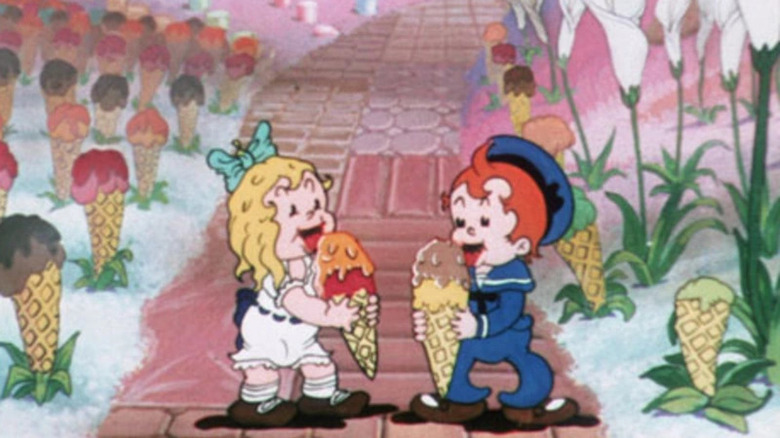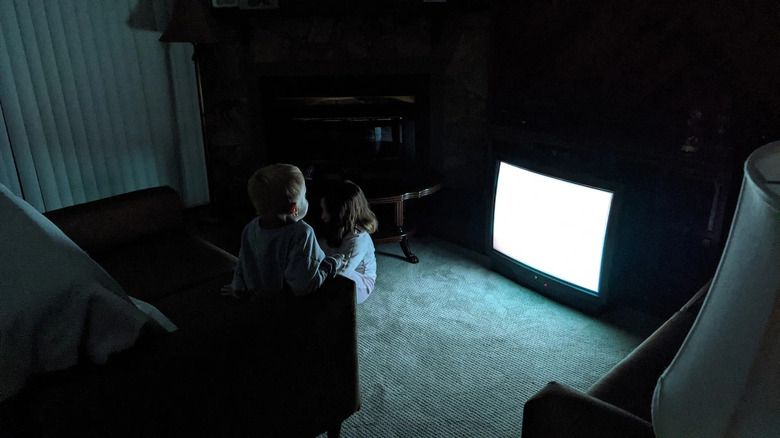The Cartoon Connection To Skinamarink
Kyle Edward Ball's "Skinamarink" is a singular horror movie experience that /Film heralds as an early contender for the scariest movie of 2023. The abstract story follows two young children, Kevin and Kaylee, tiptoeing around their house at night. As they search for their parents, they discover the doors and windows have mysteriously gone missing.
"Experience" is the appropriate word for watching this film that strips all narrative and visual traditions. Ball rarely focuses on the children's faces and only part of their bodies, instead angling his camera on walls, doors, and other parts of the home. Dialogue is difficult to hear and is only occasionally understood through subtitles. Jamie McRae's scratched and grainy cinematography adds a lo-fi aesthetic that reflects the 1990s setting. The darkened surroundings are indistinguishable, with only the flicker of the television or a hallway night light shining through.
Public domain cartoons from the 1930s play on VHS throughout "Skinamarink," two from Dave Fleischer ("The Cobweb Hotel" and "Bimbo's Initiation") and one by Max Fleischer ("Somewhere in Dreamland"). Kyle Edward Ball tells Filmmaker Magazine that these free cartoons, which are "sentimental and creepy and weird," adds to the film's uncanniness. One of these cartoons is very similar to the "Skinamarink" story.
Life is but a dream
"Somewhere in Dreamland" and "Skinamarink" are two sides of the same coin. Both are about a brother and sister struggling with traumatizing situations who slip into a dreamy world. Set during the Great Depression, the siblings in "Somewhere in Dreamland" wear tattered clothes and have blankets with holes. They bring home firewood for their weary mother who gives them pieces of hard, dry bread for dinner.
At night, they dream of a brightly-colored land filled with ice cream cones sprouting from the ground, cornstalks raining popcorn, a carousel made of a giant cake, and plush beds fit for a prince and princess. The ultimate fantasy of this sweet-natured cartoon juxtaposes the pitch-black terror Kevin and Kaylee endure in "Skinamarink."
"Somewhere in Dreamland" has an uplifting ending where the neighbors donate food, toys, and clothing to the penniless family. In the last shot, the little boy pokes himself with a fork to make sure he is not still dreaming. The strange ending of Ball's film does not make it clear if the children are dreaming or awake, living or dying. The final images of spilled blood and a half-formed face peering out of the shadows are haunting.
"Somewhere in Dreamland" is a straightforward and simple tale of a girl and boy in their happiest dream. The cartoon is a feast for the eyes that marvels at delicious food from a magical land. A reversal of this story, "Skinamarink" traps the siblings in a murky nightmare. You never know exactly what you're looking at. Yet both films are strong examples of how meaningful dreams are for children, revealing their greatest wishes or deepest fears.
Childhood memories
I was struck by the use of the cartoon "Somewhere in Dreamland" in the experimental "Skinamarink." I fondly remember watching this short film on a Christmas-themed VHS tape when I was Kevin and Kaylee's age during the 1990s. This recognition felt especially poignant because "Skinamarink" is a film that touches on both primordial fears and nostalgic memories.
Kyle Edward Ball uses such avant-garde and immersive visual techniques to make his audience feel like children again, lost in an uncertain adult world and terrified of the dark. In an interview with The Daily Beast, he talks about how "Skinamarink" has a home movie spirit:
"I did want to make a movie where everyone who watches it feels their own personal thing about it and they feel like the movie is just made for them . . . It's not my movie anymore — it's your movie."
The inclusion of "Somewhere in Dreamland" made "Skinamarink" deeply personal to me. The less than 10-minute cartoon left an indelible impression on my memory; I never forgot how sad I was for the children and how it warmed my heart when the community came together to help them. "Skinamarink" captures this childhood sensation where certain movies, dreams, or nightmares can imprint our minds for the rest of our lives.


